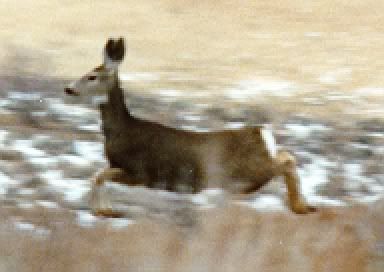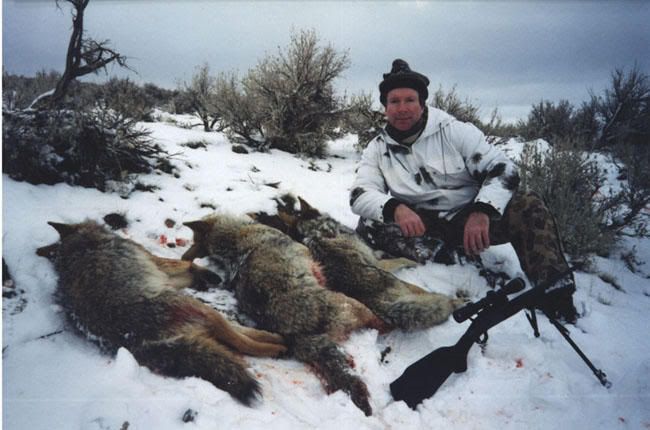When are Mule Deer Fawns born ?
Since the gestation period for mule deer is about 210 days, if you know when the rut occurs, then you will know when to expect baby deer. Or, in like manner, if you know when the fawns are born, then you know when the rut occurs. In my home area of North Central Arizona, the firs t fawns are born about the end of July. This may be a surprise to some. It was a surprise to me. The peak birthing period here is mid August. That is when the typical Arizona monsoon hits. This timing is about 2 months later than, say Western Colorado. If I work backwards, that means our local rut is around mid to late January.
t fawns are born about the end of July. This may be a surprise to some. It was a surprise to me. The peak birthing period here is mid August. That is when the typical Arizona monsoon hits. This timing is about 2 months later than, say Western Colorado. If I work backwards, that means our local rut is around mid to late January.
It just so happens that, here in Arizona, I can buy an over-the-counter archery tag that lets me hunt during the rut in certain areas.
Since I am a Mule Deer Fanatic, and a serious student of the Mule Deer, I watch the mule deer near me with keen interest. I know that the fawns that are being born are disappearing just about as fast as they hit the ground. I know that the does separate themselves from the other animals just before fawning. I know that they typically give birth in the middle of a park, which is what I would expect of an antelope. I presume this is a predator evasion strategy. It doesn’t seem to be working too well, however. There are so many coyotes in our area that the deer, and the small game, for that matter, don’t have much of a chance to survive. I see these deer every day – so I can tell when a doe is pregnant, and I can tell when she has delivered. If I see fawns with their mother, and then they disappear, I deduce a predator problem. We do not have a habitat problem per se, and we do not have winter kill.
Last year, we ended up with about 0.5/1.0 fawns per doe. That’s pretty sad. It looks like it is going to be even worse this year. Have you ever wondered what this ratio should be? If you were a deer rancher, you would want to net at least 1.5/1.0 fawns per doe. Is that possible, you ask. Why, yes it is. If our agencies were even half good game managers, that is what we could expect from them. This type of ratio is essential to a growing herd and to having surplus deer. That is why we have hunting – because of the capacity of deer herds to produce a surplus. Today, we are giving the lion’s share of that surplus capacity to predators.
It is “normal” for a “heifer” doe to have a single fawn for her first birthing experience at age 2 1/2. After that, until she goes through menopause, she will typically have twins, occasionally triplets. Let’s say that a doe will have seven birthing experiences in her lifetime, then we could expect her to deliver 11-13 fawns. I should interject here – this is why we don’t kill does. About 55% of the fawns will be buck fawns, so we could expect something like seven buck fawns and six doe fawns from a single, healthy doe. By the time a doe expires, let’s say, at age ten, between her and her offspring, there would be approximately 340 fawns delivered, of which about 190 would be bucks. Thinking about these prospects should make any Mule Deer Fanatic happy. Then you think about the current state of mule deer mis-management and you get sad.
Thinking about these prospects should make any Mule Deer Fanatic happy. Then you think about the current state of mule deer mis-management and you get sad.
So, keep an eye on your own deer herd and see what you can learn. If you see low fawn/doe ratios, you can start killing coyotes.

I just read the 2007 article about mule deer. I have a cabin in Northern New Mexico and have spend more time watching mule deer than working on the cabin. Every minute is bliss. I saw a buck feeding with a doe and two fawns for 30 mintues. At one point he pushed one of the fawns with his hoof and then the two fawns lay down under a juniper. I had heard that bucks do not hang out with the doe/fawns but I believe they do. I saw 3 sets of fawns with their moms within a 10 minute drive in late July near my cabin. Can’t get enough. Saw 5 big bucks hanging out on Sept 5, nice borthday present for me!
Live in Colorado and love watching all the mule deer. On female had a fawn with her and today I don’t see it with her. Does that mean it’s gone?
We live in a residential neighborhood in Sandy Utah, about a half mile from the Wasatch Mountains. We have a year-round group of Mule Deer living in the neighborhood. On Memorial Day weekend a doe gave birth to TRIPLET fawns in our back yard. As of yesterday the fawns are robust and healthy and follow the mom around while she browses the neighborhood. The mama deer has become quite friendly and uses our backyard as a safe haven, spending much of the day resting in the shade. When available, we throw small quantities of kitchen scraps such as stale bread, apple chunks, moldy fruit (strawberries, grapes) and recently, watermelon rinds out on the back lawn. Needless to say, all disappear by morning. The interesting thing is that our ornamental shrubs remain un-eaten and intact. We believe that these occasional snacks fulfill their “browsing-quota” for our yard and they move on to browse elsewhere. On an interesting note, the mama deer will approach us when we enter the back yard expecting a handout. A week ago she actually took apple chunks out of my hand while I was dropping them on the lawn…… Great experience! We try not to habituate them to food dependence, but it seems reasonable to provide a safe haven for the fawns until they get old enough to go it on their own in the neighborhood. We have moderate vehicular traffic, but there are several road-kills each year, usually by kids speeding thru the neighborhood at night. …… Time will tell. PICS available upon request…..rayrack@yahoo.com
Howdy Ray,
It’s wonderful that you feed and protect the deer as you do… we do the same with apples and alfalfa pellets! We LOVE to see the local deer, and especially those adorable fawns. But please don’t feed them moldy friut or veggies. Mold is good for nobody’s tummy! Old, bruised, over-ripe is fine… just no mold!
A fellow nature-lover in Oregon
I live in Southwestern NM, and see the main buck, a six pointer, hanging out with and eating with the primary doe and her fawns and yearlings all the time. Like a family affair, actually. I’ve seen the yearlings go up to him and sniff his antlers and brush their heads against them. I’ve also seen him standing watch over does while they eat. And these are mule deer! Our does give birth around May, maybe earlier.
I am so happy there are deer lovers out there. We have had a family of Mule Deer coming to our yard for several years now. We have had twin fawns born in our backyard, I have watched the mating process in our front yard every Fall, here it is October/November and the fawns are born in May or June. I guess it is earlier here because we are farther North (Alberta, Canada). We feed our deer apples, carrots and alfalfa mix also, especially in the winter. We are to the point where we can hand feed them and stroke their nose, they are so friendly. We have had several generations of fawns born here now, so can have quite a gathering when they all visit, all descendants of Zelda (the first one to enter our lives). In early Spring there is a bit of a territory battle (Mule Deer are very gentle souls, so nothing violent).
Feeding deer is generally counter productive and illegal in many states…. they know how to forage for what they need, you’re doing a disservice to them by providing constant food supply